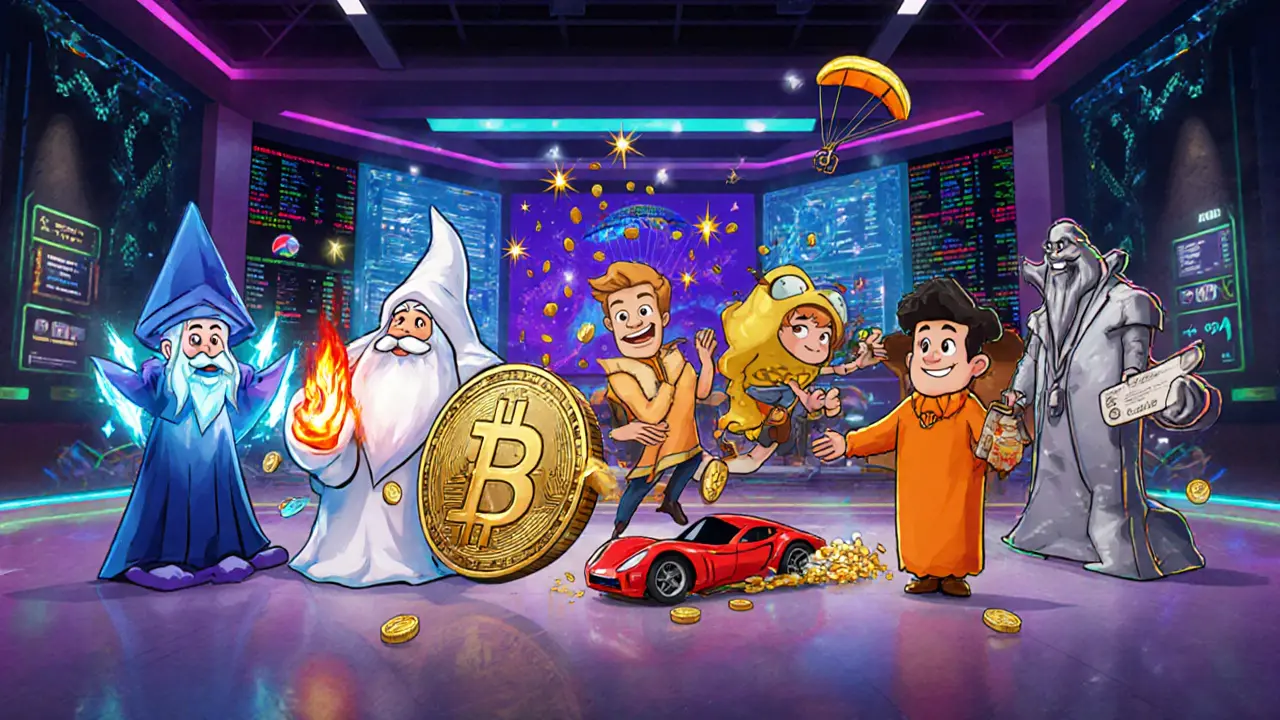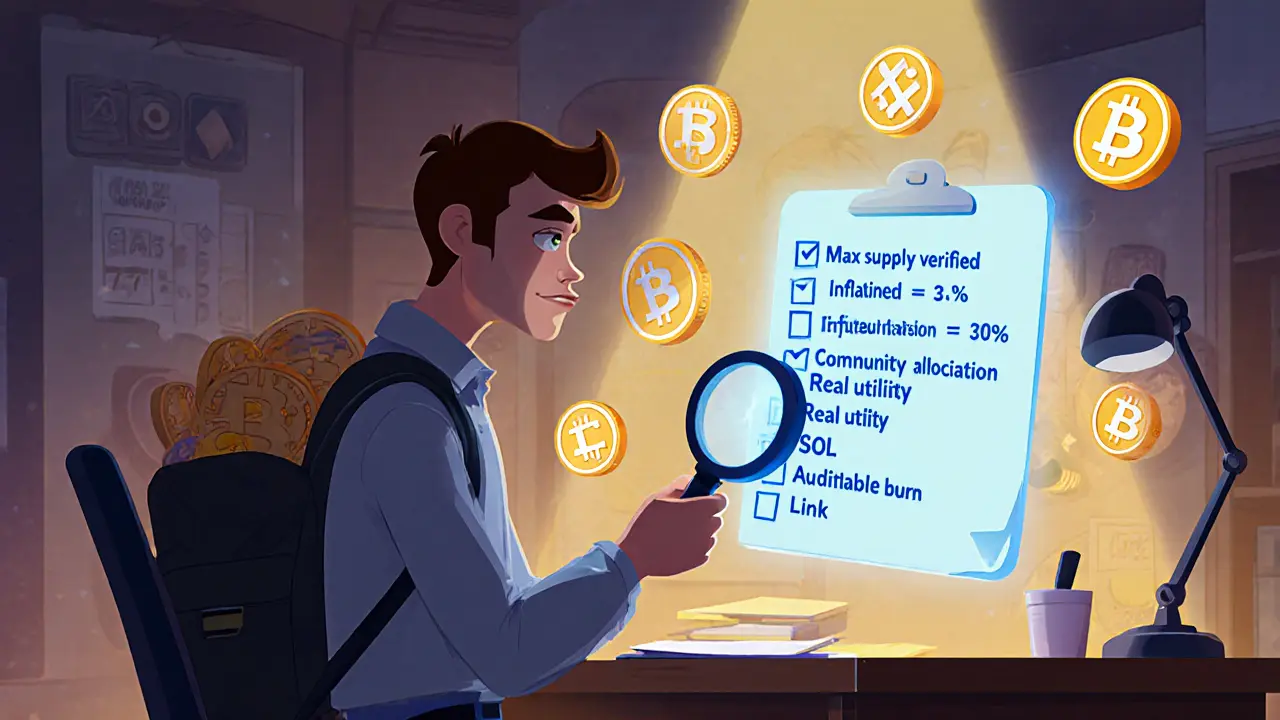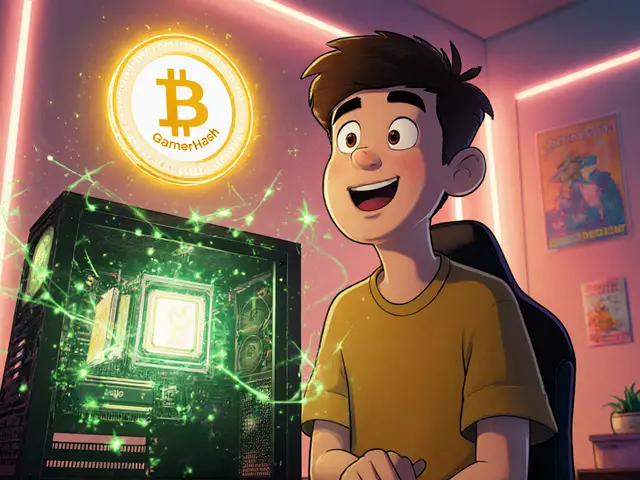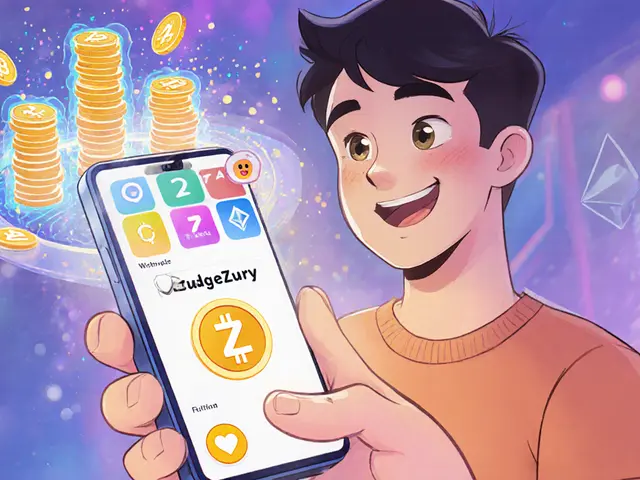Key Takeaways
- Good tokenomics blend predictable supply rules, real utility, and fair distribution.
- Ethereum, Avalanche, Binance Coin, Solana and Hyperliquid are industry benchmarks.
- Deflationary mechanisms (burns, fee‑based reductions) keep long‑term value healthy.
- Look for community‑centric allocation (30%+ of supply) and transparent vesting.
- Use a simple checklist - supply caps, inflation rate, utility penetration, burn verification - to vet any new token.
When evaluating crypto projects, Tokenomics is the economic model that governs a token's supply, distribution, utility, and value accrual mechanisms. A solid tokenomics design can mean the difference between a token that survives market cycles and one that vaporizes after a hype burst. Below you’ll find real‑world good tokenomics examples that illustrate how the right mix of inflation control, utility loops, and community incentives creates lasting demand.
What Makes Tokenomics "Good"?
Experts agree on four pillars:
- Transparent supply schedule - clear max caps, yearly inflation limits, and verifiable burn logs.
- Genuine utility - the token must be required for core protocol functions (staking, gas, governance).
- Fair distribution - a meaningful slice goes to the community, with team allocations under 15% and long‑term vesting.
- Alignment of incentives - token holders benefit when the network grows, not just when speculation spikes.
CoinGecko’s 2024 Crypto Adoption Report shows projects that nail these pillars enjoy a 63% higher survival rate during bear markets. In practice, the best models blend modest inflation with periodic deflationary pressure.
Benchmark Tokenomics Models
Let’s walk through six tokens that consistently rank high on Messari’s Tokenomics Grading System.
Ethereum
Ethereum started as a pure inflation token but shifted to a deflationary regime with EIP‑1559. Since its 2021 launch, the protocol has burned more than 4.1 million ETH (≈ $12.8B) by routing a portion of transaction fees to a burn address. The rate caps at roughly 2‑3% annual inflation, and the supply is uncapped but effectively controlled by the burn mechanism. Utility is baked in: ETH powers gas fees, staking, and a massive DeFi ecosystem (4,852 protocols). This mix earns Ethereum a Tokenomics Health Score of 92/100.
Avalanche
Avalanche’s AVAX token has a hard cap of 720M, with three independent burn streams - gas fees, subnet creation fees, and validator staking fees. As of September2025, about 36% of the total supply has been burned, creating a measurable 1.2% annual deflationary pressure. Community incentives account for 30%+ of the allocation, and the network processes over 4,500 TPS, giving AVAX solid utility across DeFi, NFTs, and enterprise subnets.
Binance Coin (BNB)
BNB’s quarterly burn events are a textbook example of predictable deflation. By July152025, the 24th burn had destroyed 20.65M BNB (≈ $10.3B), shaving the total supply from 200M to 128.8M. The burns are funded by a share of Binance’s quarterly profit, tying token reduction directly to real revenue. BNB also powers transaction fees on Binance Smart Chain, staking, and launchpad participation, aligning holder interests with ecosystem growth.
Solana
Solana caps SOL at 555M and employs a declining inflation schedule: 8% at launch, tapering to 1.5% over eight years. The network’s ultra‑low fees (≈ $0.00025 per tx) and 65,000 TPS capacity fuel high transaction volume, creating natural demand. However, critics point out that 42.7% of SOL remains with the foundation and early investors, a concentration risk that keeps its tokenomics score at 80/100.
Hyperliquid
Hyperliquid launched a 1B token with a community‑first distribution: 76.3% (763M) went to users via airdrop, 12% to the team, and 11.7% to ecosystem development. No venture‑capital pre‑sale means the token’s price action reflects pure user demand. The token is used for fee discounts on the Hyperliquid exchange, tying utility to real trading volume.
Chainlink (LINK)
Chainlink introduced a burn mechanism in September2025 that consumes 10% of oracle fees each month. This adds a revenue‑linked deflationary layer to an otherwise uncapped supply. With over 350k active node operators securing $35.7B in DeFi value, LINK’s utility is unquestionable, even if the supply could swell to 1B by 2030.

Side‑by‑Side Comparison
| Token | Max Supply / Cap | Annual Inflation (post‑launch) | Deflationary Mechanism | Community Allocation | Utility Highlights |
|---|---|---|---|---|---|
| Ethereum | Uncapped (burn‑controlled) | ≈2‑3% | EIP‑1559 fee burn | ~30%in staking rewards | Gas, staking, DeFi, NFTs |
| Avalanche | 720M AVAX | ~1% (net after burns) | Triple‑fee burns (gas, subnet, staking) | 35%to validators & community | Fast contracts, subnets, DeFi |
| BNB | 200M → 128.8M (post‑burn) | ~1% (net) | Quarterly profit‑linked burns | 40%in ecosystem fund | Exchange fees, BSC gas, launchpad |
| Solana | 555M SOL | 8% → 1.5% (declining) | No regular burns (planned upgrade) | ~38%foundation + early investors | High‑throughput apps, low fees |
| Hyperliquid | 1B HYP | 0% (fixed supply) | None (fee discounts instead) | 76.3%airdrop to users | Exchange fee discounts, liquidity mining |
| Chainlink | Uncapped (dynamic) | ~0.5% (net after burns) | 10% of oracle fees burned monthly | 20%to node operators | Decentralized oracles, data feeds |
How to Evaluate a New Token’s Economics
Use this quick checklist before you allocate capital:
- Is there a clear max supply or a verifiable burn schedule?
- What is the post‑launch inflation rate? Aim for ≤3% annual.
- How much of the supply is earmarked for the community (airdrop, staking rewards, liquidity incentives)? Target >30%.
- Does the token have a real utility (gas, staking, governance, fee discounts) rather than pure speculation?
- Are the burn or fee‑revenue mechanisms auditable on‑chain?
- Check the team allocation and vesting cliffs - < 15% and >12‑month cliff is healthy.
- Review the token’s governance model. Does token‑holder voting affect key parameters?
Projects that tick most of these boxes typically score 80+ on Messari’s grading system and attract institutional capital.
Common Pitfalls and How to Spot Them
Even promising projects can hide red flags:
- Over‑concentrated holdings - if >40% sits with founders or a single exchange, market manipulation risk spikes.
- Vague burn claims - many tokens announce “burns” without on‑chain proof. Look for verified burn contracts (e.g., Etherscan for ETH burns).
- Excessive team allocation - anything above 20% with short vesting periods often leads to dump events.
- Utility advertised but unused - check on‑chain metrics like % of tokens actually staked or used for fees.
Reddit’s r/DeFi community documented a 2024 token that allocated 70% to the team and crashed 98% in value within three months of unlock. That’s a textbook case of flawed tokenomics.

Emerging Trends in Tokenomics Design
2025 has been a year of experimentation:
- Restaking models (e.g., EigenLayer) let ETH be reused for security across multiple protocols, creating new revenue streams and secondary burn opportunities.
- Revenue‑linked burns - Chainlink’s oracle‑fee burn and BNB’s profit‑share burn tie token reduction directly to real earnings.
- Multi‑deflationary layers - upcoming SOL 2.0 proposes fee burning on top of inflation reduction, aiming for a net deflationary stance.
- Regulatory‑driven transparency - the SEC’s 2025 framework forces projects to publish detailed tokenomics whitepapers, making auditability easier for investors.
Gartner predicts that by 2027, 90% of new token launches will embed at least two deflationary mechanisms, a sharp rise from the 37% figure in 2025.
Next Steps for Crypto Enthusiasts
If you’re hunting for the next solid token, start with the checklist above, then deep‑dive into the on‑chain data. Tools like CryptoSlate’s Tokenomics Explorer or ConsenSys Academy’s evaluation framework can help you verify burn logs and staking ratios. For an organized learning path, consider the "Advanced Tokenomics" Coursera course - it’s been a go‑to for over 14k students since early 2025.
Frequently Asked Questions
What is the difference between inflationary and deflationary tokenomics?
Inflationary tokenomics increase the circulating supply over time, usually to reward stakers or fund development. Deflationary tokenomics reduce supply via burns, fees, or token‑buy‑backs, aiming to create scarcity and support price growth. Good designs often blend a low inflation rate (2‑3% annually) with periodic burns to keep net growth modest.
How can I verify if a token’s burn mechanism is real?
Check the token’s smart contract on a block explorer (Etherscan for ERC‑20, BscScan for BEP‑20). Look for a “burn” address (often 0x000…dead) and transaction logs that move tokens there. Projects like Ethereum publish daily burn totals, and BNB’s quarterly burn reports are linked to on‑chain proof.
Why does community allocation matter?
A larger community share (typically >30% of total supply) means more users have skin in the game, which drives network usage, voting participation, and price stability. Tokens that concentrate most coins with the founding team are prone to dump events when vesting cliffs expire.
Can a token with a fixed supply still have inflation?
Yes, if the protocol mints new tokens for rewards or fees, the effective inflation rate rises even with a hard cap on total supply. That’s why many projects track “net inflation” after accounting for burns.
What red flags should I watch for in a token’s vesting schedule?
Beware of short cliffs (less than 12 months) and large unlocks (over 10% of total supply) that happen simultaneously. Such schedules can trigger massive sell pressure, as seen in the 2024 incident where a 70% team allocation dumped within weeks of its first unlock.




23 Comments
Steve Cabe
The United States crypto ecosystem thrives when tokenomics are built on clear, domestic fundamentals. A predictable supply schedule gives investors confidence that the project isn’t a foreign puppet. Real utility, such as gas fees and staking, ties the token to the network’s health. Fair distribution ensures the community, not offshore whales, reap the rewards. In short, strong tokenomics protect American innovation.
shirley morales
Tokenomics is a sacred art. Only the enlightened grasp its subtleties.
Mandy Hawks
When we look beyond the numbers, tokenomics becomes a reflection of collective intent. The community allocation acts as a moral compass, guiding the network toward shared prosperity. If the supply is too concentrated, the token mirrors a plutocratic system, not a democratic protocol. Conversely, a transparent burn schedule signals accountability to all participants. The interplay between inflation and deflation is akin to a philosophical dialectic, constantly evolving. Stakeholder incentives must align with long‑term ecosystem health, otherwise the system collapses under short‑term greed. The best models respect both the economic realities and the human need for trust. Ultimately, good tokenomics is a quiet agreement that the network belongs to its users.
Millsaps Crista
Great points on burn mechanisms! The community really benefits when supply is actively reduced. It creates a tangible scarcity that supports price stability. Plus, tying token utility to real network functions boosts demand. Keep pushing for transparent vesting schedules.
Jordan Collins
The checklist you provided is solid, especially the emphasis on max‑supply clarity. I’d add that monitoring on‑chain burn logs weekly can catch hidden risks early. When evaluating inflation, remember to factor in net inflation after burns. Community allocations above thirty percent are crucial for network effects. Also, verify that governance truly allows token‑holder proposals to adjust parameters. Overall, the framework you outlined matches what institutional investors look for.
Michael Bagryantsev
On‑chain data validates the burn claims.
Kim Evans
Nice summary 😊
Scott G
The article rightly underscores the necessity of verifiable burn contracts. It is prudent to audit the contract addresses directly on Etherscan. A transparent vesting schedule mitigates the risk of sudden token dumps. Investing with such rigor aligns with best‑practice risk management.
Russel Sayson
The deflationary angle is compelling, yet many projects overstate its impact. A burn that represents less than half a percent of daily volume barely shifts scarcity. Look for mechanisms that tie burns to revenue streams, like BNB’s profit‑linked reductions. Otherwise, you’re just creating a cosmetic reduction. Also, be wary of tokens that claim “unlimited burns” without a clear on‑chain path. The community allocation numbers matter-if a single entity controls more than twenty percent, expect price volatility. In my experience, projects that combine modest inflation with multi‑layer burns sustain value longer. Finally, always cross‑reference the token’s whitepaper with actual on‑chain events; discrepancies are red flags. The interplay of utility and tokenomics is where genuine value emerges.
Isabelle Graf
This is obvious.
Blue Delight Consultant
While the article is comprehensive, I must point out a few minor issues. The term "definitly" is misspelled; it should be "definitely". Also, the section on revenue‑linked burns could use a deeper analysis of how it affects token velocity. Nevertheless, the overall structure is sound and will help beginners navigate tokenomics. I appreciate the effort put into gathering these examples.
Wayne Sternberger
The guide is helpful, however some sections feel a bit rushed. For instance, the discussion on SOL's inflation could mention the upcoming fee‑burn upgrade. Also, the typo "defiantly" appears in the utility paragraph – it should read "defiantly"? Anyway, the core concepts are well covered and I’ll share this with my dev team.
Gautam Negi
Interesting perspective, yet I remain sceptical about the hype around restaking. While EigenLayer offers novel revenue streams, it also concentrates risk across multiple protocols. The article could benefit from a balanced view of potential attack vectors. Still, the inclusion of emerging trends adds value to the piece.
Shauna Maher
Sounds like a scam.
Kyla MacLaren
I agree with the checklist.
Linda Campbell
The emphasis on transparent burns resonates strongly. It is vital that tokenomics remain auditable and free from opaque manipulations. Community‑first allocations also foster genuine network effects. However, over‑centralisation, as seen with SOL, remains a concern. Overall, the article provides a solid framework.
John Beaver
Burn data is on Etherscan.
EDMOND FAILL
Cool breakdown, love the practical tips. The checklist is exactly what I needed before diving into a new project. I’ll definitely use the on‑chain explorers you mentioned. Thanks for making tokenomics less intimidating.
Brian Elliot
Your analysis aligns with what we see in the market. The focus on community allocation is crucial for sustaining long‑term interest. I would also monitor the governance model closely, as token‑holder voting can shift tokenomics over time. The examples you listed illustrate both best practices and pitfalls well. Keep up the thorough work, it benefits many of us trying to navigate this space.
Marques Validus
Yo, let me break it down for the r/DeFi crowd – this post is pure gold, a legit cheat‑sheet for tokenomics nerds. First off, the burn‑and‑earn model is the MVP of token design, you gotta have that feedback loop where fees get torched, otherwise you just pump dust. Second, the community allocation isn’t just a nice‑to‑have, it’s the lifeblood – think of it as the DAO’s marrow, if you skimp on that you’re basically handing the reins to a handful of whales and the whole thing goes south faster than a meme coin after a pump. Third, the utility‑centric approach – gas, staking, governance – that’s the holy trinity, you want your token to be inseparable from the protocol’s core, not just a speculative ticker. Fourth, the deflationary layers – multi‑burn streams, revenue‑linked burns, token‑buy‑backs – they stack like compound interest, amplify scarcity, boost price floor, you feel me? Fifth, the vesting cliffs – you need cliffs longer than a Netflix binge, otherwise you’re setting up a dump party. Lastly, transparency – audit the contracts, check the on‑chain burn logs, make sure the whitepaper isn’t a smoke‑screen. TL;DR: max supply or burn‑controlled, community >30%, real utility, deflationary layers, long cliffs, open audits. Follow that checklist and you’ll dodge the rug‑pulls faster than a hacker avoids a 2FA prompt. Stay savvy, fam.
Mitch Graci
Wow, what a masterpiece… 🙄
Teagan Beck
Interesting take.
VEL MURUGAN
Your logic is flawed.